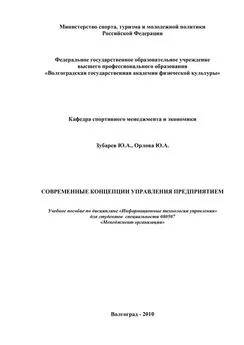Фонс Тромпенаарс - 100 ключевых моделей и концепций управления
- Название:100 ключевых моделей и концепций управления
- Автор:
- Жанр:
- Издательство:Манн, Иванов и Фербер
- Год:2020
- Город:Москва
- ISBN:978-5-00100-648-0
- Рейтинг:
- Избранное:Добавить в избранное
-
Отзывы:
-
Ваша оценка:
Фонс Тромпенаарс - 100 ключевых моделей и концепций управления краткое содержание
Необходимое издание для менеджеров любого уровня, а также для тех, кто изучает науку управления.
100 ключевых моделей и концепций управления - читать онлайн бесплатно ознакомительный отрывок
Интервал:
Закладка:
Drucker, P. F. (2001) T he Essential Drucker — The Best of Sixty Years of Peter Drucker’s Essential Writings on Management , New York, HarperCollins.
Drucker, P. (2007) Innovation and Entrepreneurship: Practice and Principles , New York, Routledge.
Duarte, N. (2012) HBR Guide to Persuasive Presentations , Boston, Harvard Business Review Publishing.
Duhé, S. (Ed). (2012) New Media and Public Relations , 2nd Ed., New York, Peter Lang Publishing.
Dumetz, J. (2012) Cross-Cultural Management Textbook: Lessons from the World Leading Experts in Cross-Cultural Management , CreateSpace Independent Publishing Platform.
EFQM (2012) EFQM Excellence Model 2013 , Brussels, EFQM.
Elkington, J. (1997) Cannibals with Forks: The Triple Bottom Line of 21st Century Business , Mankato, Capstone.
Elton Mayo, E. (1993) The Human Problems of an Industrialized Civilization , Boston, Harvard University Press.
Evans, J. R., Lindsay, W. (2011) Managing for Quality and Performance Excellence (8th edition), Mason, South-Western Cengage Learning.
Evers, G. H.M, Verhoeven, C. J. (1999) Human Resources Planning: een integrale benadering van personeelsplanning , Deventer, Kluwer.
Farris, P. W., Bendle, N. T., Pfeifer, P. E., Reibstein, D. J. (2010) Marketing Metrics: The Definitive Guide to Measuring Marketing Performance (2nd Edition), Upper Saddle River, Pearson.
Foley, J., Kendrick, J. (2006) Balanced Brand: How to Balance the Stakeholder Forces that Can Make or Break Your Business , San Francisco, Jossey-Bass.
Freeman, R. E. (1984) Strategic Management: A Stakeholder Approach , Boston, Pitman.
Freeman, R. E., Harrison, J. S., Wicks, A. C., Parmar, B. L., de Colle, S. (2010) Stakeholder Theory — The State of the Art, Cambridge , Cambridge University Press.
Freeman, R. E., McVea, J. (2001) ‘A Stakeholder Approach to Strategic Management’, Darden Business School Working Paper no. 01–02, available online at Social Science Research Network.
Friedman, M. (1970) ‘The Social Responsibility of Business is to Increase its Profits’, New York Times , September 13.
Friedman, T. (2005) The World is Flat , New York, Farrar, Straus and Giroux.
Fukuyama, F. (1992) The End of History and the Last Man , New York, The Free Press.
Fullagar, C., Kelloway, E. K. (2013) ‘Work-Related Flow’, in A Day in the Life of a Happy Worker , edited by A. B. Bakker and K. Daniels, East Sussex, Psychology Press.
Furrer, O., Tjemkes, B. V., Aydinlik, A.Ü., Adolfs, K. (2012) ‘Responding to Adverse Situations Within Exchange Relationships: The Cross-Cultural Validity of a Circumplex Model’, Journal of Cross-Cultural Psychology , 43:6, pp 943–966.
Garrett, J. J. (2002) T he Elements of User Experience: User-Centered Design for the Web and Beyond , Berkeley, New Riders.
Gerstner, L. (2002) Who Says Elephants Can’t Dance , New York, HarperBusiness.
Getzels, J. W., Jackson, Ph.W (1962) Creativity and Intelligence , London, John Wiley.
Gilligan, C. (1982) In a different voice: Psychological Theory and Women’s Development , Boston, Harvard University Press.
Gladwell, M. (2009) Outliers: The story of success , London, Penguin.
Goldstein, N. J., Martin, S. J., Cialdini, R. B. (2008) Yes! 50 Scientifically Proven Ways to be Persuasive , New York, The Free Press.
Gordon, T., Burch, N. (2003) Teacher Effectiveness Training: The Program Proven to Help Teachers Bring Out the Best in Students of All Ages , New York, Random House.
Govindarajan, V., Trimble, C. (2012) Reverse Innovation: Create Far From Home, Win Everywhere , Boston, Harvard Business Press.
Grant, R. M. (2013) Contemporary Strategy Analysis: Text and Cases , 8th ed., Chichester, Wiley Blackwell.
Greenleaf, R. K. (1973) The Servant as Leader , Peterborough, Center for Applied Studies.
Greenleaf, R. K., Spears, L. C., Covey, S. R. (2002) Servant Leadership: A Journey into the Nature of Legitimate Power and Greatness , 25th Anniversary Edition, Mahwah, Paulist Press.
Greiner, L. E. (1998) ‘Evolution and Revolution as Organizations Grow’, Harvard Business Review , May — June, pp 55–68.
Grönroos, C. (2007) Service Management and Marketing (3rd ed), Chichester, John Wiley.
Groysberg, B., Slind, M. (2012) ‘Leadership is a Conversation’, Harvard Business Review , June, pp. 75–84.
Guest, D., Paauwe, J., Wright, P. M. (2013) HRM and Performance: Achievements and Challenges , Chichester, John Wiley.
Gutman, J. (1982) ‘A Means-End Chain Model Based on Consumer Categorization Processes’, The Journal of Marketing , 46:2, pp. 60.–72.
Hakes, C. (2007) The EFQM Excellence Model to Assess Organizational Performance — A Management Guide , Zaltbommel, Van Haren Publishing.
Hamel, G., Prahalad, C. K. (1994) Competing for the Future , Boston, Harvard Business School Press.
Hammer, M. (1990) ‘Reengineering Work: Don’t Automate, Obliterate’, Harvard Business Review , 68(4): pp. 104–112.
Hammer, M., Champy, J. (2003) Reengineering the Corporation: A Manifesto for Business Revolution , New York, HarperCollins.
Hammonds, K. H. (2001) ‘Michael Porter’s big ideas’, Fast Company , 44: 150.
Hampden-Turner, C. (1981) Maps of the Mind: Charts and concepts of the mind and its labyrinths, New York , MacMillan Publishing Company.
Hampden-Turner, C. (1990) Charting the Corporate Mind: Graphic Solutions to Business Conflicts , New York, The Free Press.
Hampden-Turner, C. (1995) Stages in the Development of Intercultural Sensitivity and the Theory of Dilemma Reconciliation: Milton J. Bennett and Charles Hampden-Turner’s Approaches Contrasted and Combined , Cambridge, The Judge Institute of Management Studies.
Hampden-Turner, C., Trompenaars, F. (1993) Mastering the Infinite Game: How East Asian Values are Transforming Business Practices , Oxford, Capstone.
Handy, C. (1976) Understanding Organizations , Oxford, Oxford University Press.
Handy, C. (1995) Gods of Management: The Changing Work of Organizations , Oxford, Oxford University Press.
Harrison, R. (1972) ‘Understanding your Organization’s Character’, Harvard Business Review , May — June, pp. 119–28.
Hart, S. L., Milstein, M. B. (2003) ‘Creating Sustainable Value’, Academy of Management Executive , vol. 17, No. 2, pp. 56–67.
Hart, S. L. (2010) Capitalism at the Crossroads (3rd ed.) Philadelphia, Wharton School Publishing.
Hatch, M. J., Cunliffe, A. L. (2012) Organization Theory: Modern, Symbolic, and Postmodern Perspectives , Oxford, Oxford University Press.
Hawken, P. (1993) The Ecology of Commerce: A Declaration of Sustainability , New York, HarperCollins.
Head, T. C. (2011) ‘Douglas McGregor’s Legacy: Lessons Learned, Lessons Lost’, Journal of Management History , 17:2, pp 202–216.
Heath, C., Heath, D. (2007) Made to stick: Why some ideas survive and others die , New York, Random House.
Heijde, C. M., Van der Heijden, B. I. (2006) ‘A competence-based and multidimensional operationalization and measurement of employability’, Human Resource Management , 45(3), pp. 449–476.
Henderson, B. D. (1984) ‘The Application and Misapplication of the Experience Curve’, Journal of Business Strategy , 4:3, pp 3–9.
Hersey P., Blanchard, K., Johnson, D. E. (2012) Management and Organizational Behavior , 10th ed., Englewood Cliffs, Prentice Hall.
Hersey, P., Blanchard, K. H. (1993) Management of Organizational Behavior: Utilizing Human Resources , Englewood Cliffs, Prentice Hall.
Herzberg, F. (1968) ‘One More Time: How do you Motivate Employees?’, Harvard Business Review , January — February, pp. 53–62.
Herzberg, F. (1974) ‘The Wise Old Turk’, Harvard Business Review , September — October, pp. 70–80.
Herzberg, F., Mausner, B., Bloch-Snydermann, B. (1959) The Motivation to Work , New York, John Wiley.
Heskett, J., Sasser, E., Wheeler, J. (2008) Ownership Quotient: Putting the Service Profit Chain to Work for Unbeatable Competitive Advantages , Boston, Harvard Business School Publishing.
Heskett, J. L., Jones, T. O., Loveman, G. W., Sasser, W. E., Schlesinger, L. A. (1994) ‘Putting the Service Profit Chain to Work’, Harvard Business Review , March — April, pp. 164–174.
Hill, N. (2013) Think and Grow Rich , Lindenhurst, Tribeca Books.
Hill, T., Westbrook, R. (1997) ‘SWOT Analysis: It’s Time for a Product Recall’, Long Range Planning , 30:1, pp. 46–52.
Hindle, T. (2008) Guide to Management Ideas and Gurus , London, The Economist.
Hitchcock, D., Willard, M. (2009) The Business Guide to Sustainability: Practical Strategies and Tools for Organizations , New York, Earthscan.
Hofstede, G. (1980) Culture’s Consequences: International Differences in Work-Related Values , Beverly Hills, Sage.
Hofstede, G. (1997) Cultures and Organizations: Software of the Mind , New York, McGraw-Hill.
Hofstede, G. (2003) Culture’s Consequences: Comparing Values, Behaviors, Institutions and Organizations Across Nations , Thousand Oaks, Sage Publications.
Hofstede, G., Hofstede, G. J., Minkov, M. (2010) Cultures and Organizations: Software of the Mind , New York, McGraw-Hill.
Hofstede, G., Neuijen, B., Ohayv, D., Sanders, G. (1990) ‘Measuring Organizational Cultures: A Qualitative and Quantitative Study Across Twenty Cases’, Administrative Science Quarterly , 35: pp. 286–316.
Howard, J. A., Sheth, J. N. (1969) The Theory of Buyer Behavior , New York, John Wiley.
Hsieh, T. (2010) Delivering Happiness: A Path to Profits, Passion, and Purpose , New York, Hachette Digital.
Hubbard, D. W. (2010) How to Measure Anything: Finding the Value of Intangibles in Business , 2nd ed., Hoboken, John Wiley.
Huff, A. S., Möslein, K. M., Reichwald, R. (2013) Leading Open Innovation , Cambridge, MIT Press.
Huizinga, J. (1938) ‘Homo ludens. Proeve eener bepaling van het spel-element der cultuur’, in Johan Huizinga, Verzamelde werken V (Cultuurgeschiedenis III) edited by L. Brummel et al., H. D. Tjeenk Willink and Zoon, Haarlem, 1950, pp. 26–246.
Hunicke, R., LeBlanc, M., Zubek, R. (2004) ‘MDA: A Formal Approach to Game Design and Game Research’, Proceedings of the AAAI Workshop on Challenges in Game AI , pp. 04–04.
Huntington, S. (1996) The Clash of Civilisations , New York, Simon & Schuster.
Immelt, J. R., Govindarajan, V., Trimble, C. (2009) ‘How GE is Disrupting Itself’, Harvard Business Review , 87.10, pp. 56–65.
Jablokow, K. W., Kirton, M. J. (2009) ‘Problem Solving, Creativity, and the Level-Style Distinction’, Perspectives on the Nature of Intellectual Styles , edited by R. Sternberg, New York, Springer.
James, W. (1970) Essays in pragmatism , New York, Simon and Schuster.
Jellison, J. M., (2006) Managing the Dynamics of Change: The Fastest Path to Creating an Engaged and Productive Workplace , New York, McGraw Hill.
Jeston, J., Nelis, J. (2008) Business Process Management , Burlington, Elsevier.
Читать дальшеИнтервал:
Закладка:










